
Conflict Resolution
The Australian War Memorial’s latest exhibition Afghanistan: The Australian Story is an intimate, unflinching commemoration of a war barely over. The hi-spec AV’s job is to ‘get out of the way’.
Text:/ Mark Davie
Recently, I caught Brendan Nelson’s (Director of the Australian War Memorial) Press Club address, where he promoted the importance of a war memorial’s role in defining a nation’s identity – in short, it reminds us of what we thought was worth fighting for at the time.
Perhaps Dr Nelson feels our collective memory is on the blink, because Afghanistan: The Australian Story is the first time the Australian War Memorial has installed an exhibition so soon after a conflict. The last combat troops were only withdrawn in December 2013 after 12 years of war; Australia’s longest engagement. Traditionally, a decade or more would go by before a war would be commemorated with an exhibition, but Nelson obviously wanted Australians to remember this war while it was still freshly baked in by the glare of their TVs.
Afghanistan: The Australian Story lacks the scale and spectacle of the Peter Jackson-filmed, THX-thumping Over The Front exhibition in the War Memorial’s neighbouring Anzac Hall — the screen alone would dwarf the single-storey exhibition space housing Afghanistan — but its power is in the raw delivery; story-telling without pulling punches. You only have to marry soldiers’ video accounts with the blown-up personnel carrier on display to make a solemn connection. Over The Front is like a Grandfather regaling children about the glories of war, omitting all the gory bits. Afghanistan takes you into a corner and deliberately explains why your uncle screams in his sleep.
OBJET D’ART O’ WAR
When Alex Smythe, Manager of Gallery AV Development, first arrived on staff at the War Memorial, the precedent for large-scale exhibitions had been set by the object theatre of Striking By Night, where video, light and sound augmented the story of the Memorial’s ‘G for George’ Lancaster bomber on display. Since then, it’s been a gradual refinement of the same idea, with a gradual separation of the main parts. Afghanistan: The Australian Story is a much more sensitive treatment, and eschews this traditional format because there’s no specific iconic object.
At the end of the space is one of Archibald prize-winning Ben Quilty’s arresting nudes, and elsewhere on display you’ll find a drone aircraft hanging from the ceiling, and a personnel carrier and barricade that have taken a beating. Connecting the dots with these objects of war are video projections in alcoves cut into opposite sides of the exhibition space, like arms on a cross. They’re not as obviously linked like Striking By Night, but you still take in the experience altogether; there’s no soundproofed theatrette to distance you from the objects’ reality.
Smythe: “Lighting was taken care of by the internal AV team because they rig gallery lighting all the time. It’s difficult to get right, but having really sharp, bright projectors helps. You’ve got to be very careful with spill, while still doing justice to the items you’re lighting and taking conservation values into account. It’s a bit of an art. It was a challenge getting fixtures to light the aerial drone hanging from the roof. Luckily it’s a small enough exhibition that it could be done on a fairly short lead time and with experimentation. You can’t do that if you’ve got thousands of objects to light.”
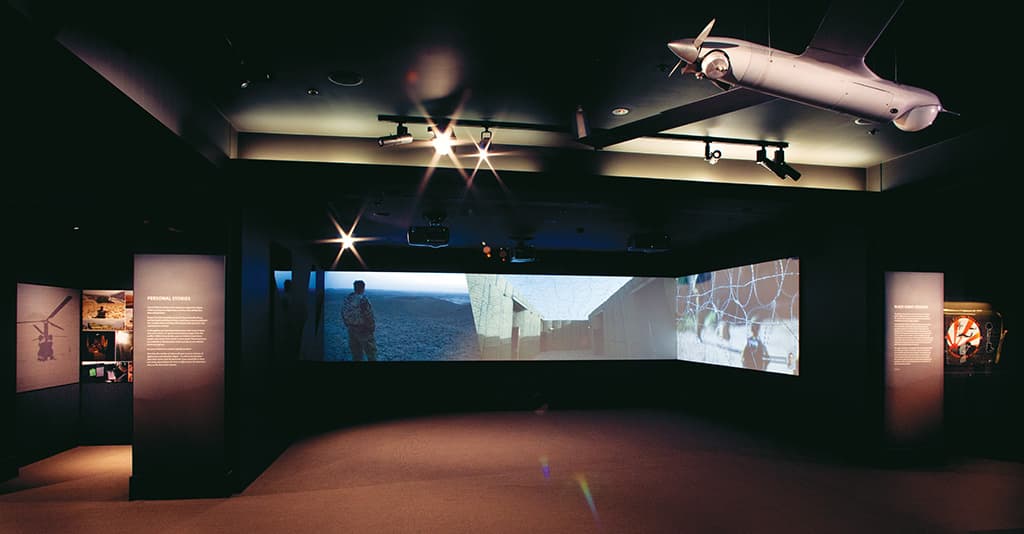
SCREENING WAR
Two of the three walls in each alcove are covered in seamless high resolution projections curated by Michael Hill and his team at Lightwell – including editors Elliott Magen and Kent Hau, and sound designer James Cecil – who combined with Freeman Ryan Design on the project. There’s 30 minutes of program that plays continuously on both L-shaped screens, essentially in front of, and behind, the viewer.
The content is a mixture of material shot by the Australian War Memorial, the Department of Defence and the ABC. Veteran journalist Chris Masters conducted interviews with a number of participants, which were used as voiceovers for the program. “The program was intended to convey the experience of what it was like in Afghanistan for the Australian participants,” said Hill. “And show a range of points of view from soldiers, diplomats, reconstruction workers, nurses, family members and also Afghani leaders.” Large-scale landscape images, helmet-cam combat footage, stills, text animation and video portraits are divided up into fragments across the six-screen canvas, to not only immerse visitors but give ample room for the differing and sometimes contradictory viewpoints.
Just some of the voices include a soldier explaining what it’s like to live with PTSD and not leaving the house for six months, and a widow recounting the day she got the devastating news of her husband’s death. There’s no ‘G for George’ glamour of war here.
“Having it on a single screen with a linear narrative wouldn’t quite do it justice,” said Smythe. “The split enables the exhibition to have more screen space, and therefore more powerful images displayed and more story covered. It’s semi-immersive; it doesn’t overwhelm like virtual reality, but it’s more than just a screen through a proscenium arch.”
Three Projectiondesign F35 panorama projectors are used to cover the two walls of each alcove, with a 25% overlap on the long walls. Interactive Controls supplied the entire video and control system, with a Medialon Showmaster ST controller at its core. The controller drives Dataton Watchout display software hosted on two custom-built computers. Each computer delivers three seamlessly-blended 2560 x 1080 dual-link DVI outputs to the projectors over Cat6 cable using Lightware adaptors and receivers.
Two touch-enabled monitors – connected to computers running Medialon’s Kiosk Touchscreen Panel application – allow gallery staff to check on the system’s status, navigate and play scenes in the program, startup/shutdown, the status of the audio tracks and their outputs, and more.
CONTAINING THE SOUND
With limited exhibition space available in the Memorial, a new chunk of real estate was requisitioned from the on-site library’s floorplan for the new exhibition. Its low ceilings lend the exhibition an intimacy worthy of the subject matter, but presented a challenge for the AV staff.
Anthony Russo: “It’s not a great room, because the ceilings are so low, and they didn’t want to see any speakers. So we had to pick the right equipment, and put supporting speakers on delay so it’s even throughout the space, rather than the sound coming out through one corner. It’s a pretty subtle difference between being annoying and localised, while remaining intelligible. We had to change it a couple of times, because of the location where sound was coming from and people speaking on the soundtrack have such different voices as well. A half a dB here or there can take attention away from the screen.”
A QSC QSys Core 250i is the controller for the audio system. Fully-spec’ed, the 250i has a capacity to handle 32 channels over AES or Cobranet. This allowed the sound designers extra flexibility to take their studio mix and mix it live in the space. The system is driven by 10 x QSC CX404 four-channel amplifiers, which pump out 400W/channel. On each side the speaker setup included:
Five Martin Audio DD6s 6.5-inch woofer two-ways used as the main LCR-type speakers. Because there were two walls to cover, these were set up as a five-channel configuration across the two walls – three on the main wall and two on the shorter. The DD6s covered patrons within the first eight metres from the screen. The DD6s have a rotatable horn, for horizontal or vertical mounting, a flexibility that comes in handy when mounting speakers in a low ceiling space.
Five Martin C4.8T four-inch two-way vented ceiling speakers were used as low-level delay fills for the main speakers. These 180°-dispersion units were placed at ceiling height as you walk into each alcove, to cover the shadow area not addressed by the main speakers.
Two Martin C8.1T eight-inch, two-way ceiling speakers were used as the surrounds in each alcove because of their more focused 90° directivity.
A Martin AQ112 direct-radiating sub was placed at ground level.
DIVIDE & CONQUER
While the visual program is split across the two sides, the audio is mirrored. Each side is set up in a 7.1 configuration, comprising Martin Audio speakers and QSC amplifiers driven by a QSC Q-Sys DSP controller.
“When you cross the room, you’re crossing an experiential divide,” explains Smythe. “The soundtrack doesn’t change at all, but there are different images on the screens. So while the soundtrack is documenting the funereal return of a soldier, the images on the screens are playing back different views of the plane, people, etc, all related to the same narrative. It’s almost the reverse of how sound normally works in a movie, where it serves to modify the images. In this case it’s the other way around.”
Initially the show was conceived as alternating from one side to the other: an active and passive side. But when the exhibition went live, that’s not the way people read it — they couldn’t figure out why the sound stopped.
Smythe: “We moved the point source effect of the sound to both sides, but kept them identical. That way you could face either way and get a coherent understanding of the story regardless of which screen you were looking at. So it was readjusting it based on the feedback of how people were using it.”
Technical Audio Group’s technical director, Anthony Russo, helped specify the system installed by Elite Sound & Lighting, and tuned the system to the program. While the Medialon server holds the audio material in 16 pre-mixed tracks, the Q-Sys controller gave that extra level of flexibility that is so important in gallery installations. “You need to build a system that has the capacity to adapt,” said Russo. “You might have a great idea about how people are going to relate to something, but then you find out they relate differently.”
FIDELITY OF INTENT
The short turnaround for the exhibition was a challenge for Smythe, who acts as a technical translator between the curatorial staff and the suppliers. Much of the planning and execution on both sides was happening in parallel, often it was about taking educated guesses where to drill a hole in the plaster, only to come back a week later and fill it in. It wouldn’t be achievable without suppliers who were sensitive to the goal.
Smythe’s goal is fidelity, but in a global way that’s not just related to technology, but subservient to the bigger idea – he aims to achieve fidelity of the curator’s intent. It demands a supremely high fidelity in the media experience to stay out of the way of this intent. Basically, the AV technology can’t limit the message.
“Exhibitions like Afghanistan aim to use AV technology in a transparent way, so it doesn’t get between the visitor and what we’re trying to represent,” said Smythe. “It’s more challenging than doing a theme park where the whole idea is to be blown away by the media experience. We’re continually aiming for more transparency.
“You have to be very sensitive with the elements you use to paint the picture of a conflict. And that comes through how you apply technology. You don’t want the content to manipulate people. You’re not trying to advertise, you’re trying to present something in an open way everyone can share and have their own relationship with.”
CONTACTS
Technical Audio Group: (02) 9519 0900 or info@tag.com.au
Interactive Controls: (02) 9436 3022 or info@interactivecontrols.com.au
Elite Sound & Lighting: (02) 6260 2311 or sales@elitesoundandlighting.com
Lightwell: (02) 9319 0311 or frontdesk@lightwell.com.au


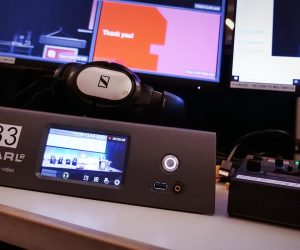


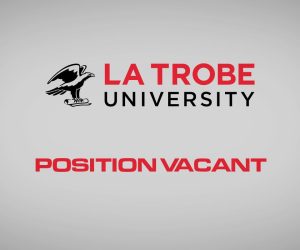





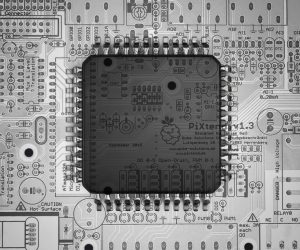
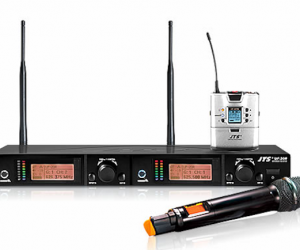


RESPONSES